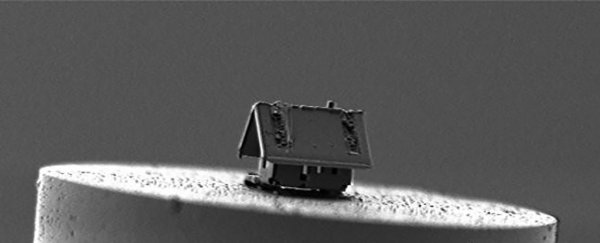You may think you've seen tiny buildings before, but this microhouse constructed by nanoengineers is the craziest one yet. From front to back it measures less than 20 micrometres, which means you could squeeze a village of 50 of them on a pinhead.
The sides of the structure are just 1.2 micrometres thick – a little over a millionth of a metre – so you could stack 60 of these walls up against each other and still have something that's thinner than a human hair.
The microscopic building was constructed on a piece of optical fibre as a way of demonstrating several innovative technologies, including some clever origami techniques and the use of an ion beam to carve out shapes at an unprecedented level of detail.
 Some of the cuts made for the house. (Femto-ST Institute)
Some of the cuts made for the house. (Femto-ST Institute)
"For the first time we were able to realise patterning and assembly with less than 2 nanometres of accuracy, which is a very important result for the robotics and optical community," says one of the team, Jean-Yves Rauch from the Femto-ST Institute in France.
"We decided to build the microhouse on the fibre to show that we are able to realise these microsystem assemblies on top of an optical fibre with high accuracy."
The main builder of the microhouse is a robot called μRobotex, and the material used was an incredibly thin piece of silica. Everything was put together in a vacuum chamber.
Using ion beams at a variety of strengths, the researchers were able to cut out the shape of the house, with natural forces creating some of the folds so the house walls stood up.
Operating μRobotex through a microscope, the team were even able to cut out a few tiles in the roof of the miniature building. A gas injection system was used to fuse the different parts of the microhouse together.
This is about much more than showing off advances in technology though: this type of method could be adapted to create very small structures for drug delivery or putting into sensors that work at the nanoscale.
Being able to create objects and manipulate them at the nanoscale opens up a wide array of possibilities for science, which is why researchers are so keen to keep pushing the boundaries of accuracy and detail with these systems.
We've already mentioned drug delivery, being able to target disease with nanoparticles that can reach deeper into the human body than ever before.
Computing can also benefit from this type of innovation – we're continuing to see storage devices get smaller and smaller, in order to store all of the data we're producing in a more compact way.
For their next trick, the researchers want to go even further. They hope to eventually get the entire house construction process automated, and piece together objects just a few billionths of a metre in size – small enough to fit inside the windows of this already teeny tiny house.
The research has been published in the Journal of Vacuum Science & Technology A.
